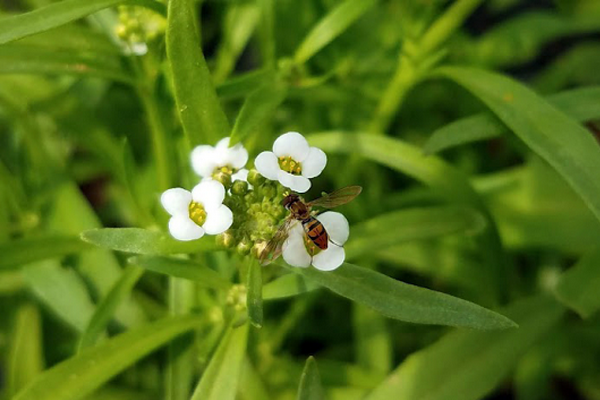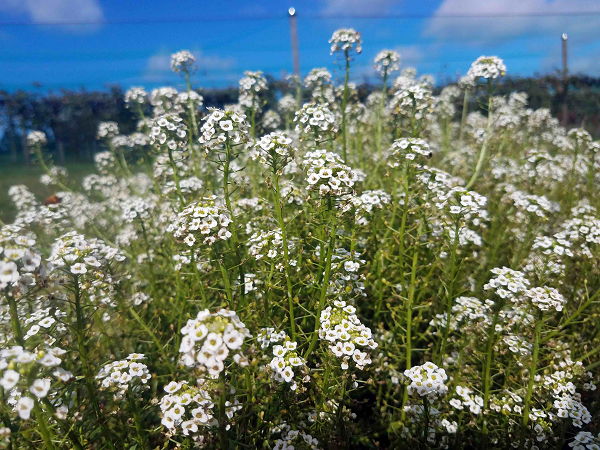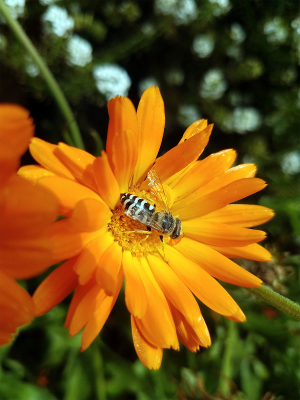National Garden Day provides a great opportunity to recognize research supported by USDA’s National Institute of Food and Agriculture. New Hampshire Agricultural Experiment Station scientists have made important discoveries about how flowering plants in the garden and other places nurture beneficial insects.
Experienced gardeners always welcome some insects among their neatly planted vegetable rows and carefully manicured flowerbeds. These insects are colloquially known as “beneficials” — those that feed on common insect pests, help break down organic material, and/or pollinate flowering plants. In the case of the former, the “beneficials” can play an important environmental and economic role as biological pest controls, which could help lower the use of pesticides, reduce labor efforts and strengthen the resiliency of organic production. And this can make a big impact on New Hampshire, where avid gardeners and small-scale agricultural production abound.

Recently, a team of New Hampshire Agricultural Experiment Station scientists made up of UNH faculty and alumni published research in Environmental Entomology examining the role of annual insectary plants—which are flowering plants grown to attract, feed and shelter beneficial insects—in serving as habitats for syrphid flies. Also known as hover or flower flies, syrphids appear as a mix of a housefly and honeybee—typically with black and white or yellow bands across their bodies—and derive their name from their behavior of hovering over flowers and other plants. And while adult syrphids prefer nectar and pollen for a meal, many species of syrphid larva will consume large numbers of common pests like aphids.
“This paper is the first report of the species composition of syrphids living and foraging in our local vegetable systems,” described co-author Anna Wallingford, an NHAES scientist and a research assistant professor in the agriculture, nutrition, and food systems department at UNH. “We knew that syrphids as a group can provide important ecosystem services, and we knew plenty about the foraging behaviors of species in the western U.S. and Europe, but now we know which species are active here in New England.”

In other parts of the U.S., particularly in California and the Northwest, farmers use insectary intercrops (plants used specifically for attracting predatory insect species) to attract and maintain syrphids. However, these practices have not been tested within the Northeast. To determine some of the more effective plants for attracting syrphids in the Northeast, the research team observed 8 insectary plant species at three sites over three years. The study was conducted at UNH’s Woodman Horticulture Research Farm; the University of Massachusetts Crop and Animal Research and Education Farm in South Deerfield, MA.; and the University of Connecticut Plant Science Research Farm in Storrs, CT.
“We’ll use this information as a springboard to study the behavior and life histories of the key players in our vegetable agroecosystems, which will lead to better landscape management techniques and more sustainable pest management down the line,” added Wallingford.
Adult syrphids will remain within an area longer if there are flowering plants to provide them with nectar and pollen. These floral resources then give the adults the reproductive power to lay their eggs near aphid colonies, where their young will predate on aphids and other soft-bodied pests. At each study site, the research team measured the density of syrphid flies and the species of the syrphid present. Because not all syrphid species attack aphids, knowing which species are present is important.

“Toxomerus marginatus, or the margined calligrapher, was the most abundant syrphid fly found in this study (about 70 percent of the total surveyed syrphids) and is known to be abundant across North America,” said co-author Alina (Harris) Cypher ’19G, an integrated pest and pollinator management specialist with the Xerces Society for Invertebrate Conservation and partner biologist with the Natural Resource Conservation Service. “In addition to eating aphids, their predatory larvae feed on a variety of other soft-bodied insects (thrips, caterpillars, mealy bugs), which suggests our insectary plant research has implications of contributing pest management services in range of crops and pest complexes.”
The researchers found that sweet alyssum (Lobularia maritima L.)—a low-growing cool-season annual in the Brassicaceae plant family—attracted the most syrphids over the course of this study. However, buckwheat, dill, and cilantro also hosted large numbers of syrphid flies and, at times, hosted more syrphids than the alyssum.
“One drawback of using buckwheat, dill, and cilantro over alyssum is that they bloom for shorter time periods, and they aren’t as cold hardy in the spring and fall,” said Cypher. “Alyssum was the standout species due to its season-long continuous bloom period that did not require multiple plantings throughout the year.”
Using an early blooming plant that can provide a continuous food source is important since the most abundant syrphid observed, T. marginatus, flies from mid-March to early October in the Northeast and year-round in some southern regions of North America.
As for the next steps in this research, Cypher said that a similar study could investigate native perennial plants to help identity which perennials could be used to attract syrphids.
“We know these native syrphid flies co-evolved with native plants, suggesting that their mouthparts and the flowers should be a perfect fit,” Cypher said. “Our most abundant syrphid fly, T. marginatus, visits native flowers in the Apiaceae family, including golden alexanders, angelica, sweet cicely, and wild lovage, as well as natives from the Anemone genus and woody natives from the genera of ninebark, blackberry, and blueberry.”
“Any of these perennial natives could be planted near cash crops to support a variety of other beneficial native insects. Unlike the annuals tested in this study, perennials wouldn’t require yearly re-plantings,” she added.
Source: nifa.usda.gov
